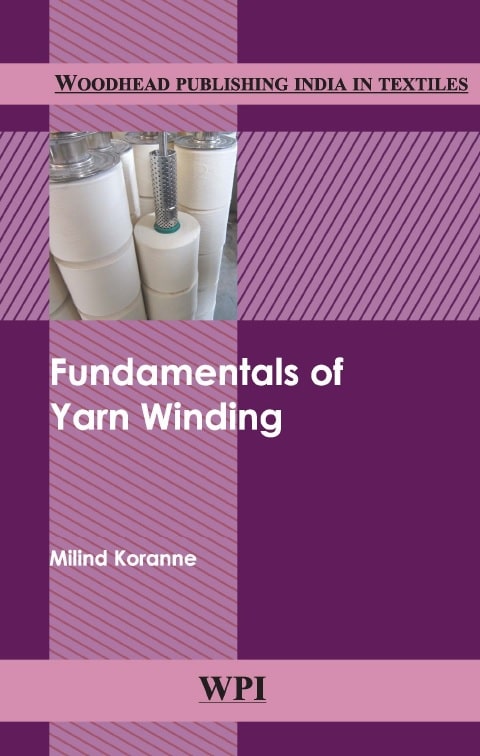
Contents
Preface ix
Acknowledgements xi
1 Winding as a weaving preparatory process 1
1.1 Weaving introduction 1
1.2 Quality requirements of warp and weft threads 3
1.3 Weaving preparatory processes 4
2 Basics of package building 12
2.1 End packages produced on winding machines 12
2.2 Some definitions related to cross wound packages 14
2.3 Traverse acceleration 16
2.4 Building a cross wound package 18
3 Principles of winding systems 34
3.1 Basic modes of winding 34
3.2 Random winding 34
3.3 Precision winding 39
3.4 Positive and negative aspects of random and precision winding 42
3.5 Step-precision winding 44
3.6 Winding systems with flexibility in package building 48
4 Winding package parameters 66
4.1 Winding system at various stages of yarn processing / production 66
4.2 Main parameters related with a winding package 69
4.3 Various end uses of wound packages 70
4.4 Yarns with diverse properties subjected to winding 71
4.5 Winding package parameters and criteria of their selection according to end-use requirements for a given yarn 71
4.6 Yarn waxing 97
5 Yarn tension during winding 100
5.1 Necessity of yarn tension during winding 100
5.2 Various supply packages on winding/rewinding machines 100
5.3 Unwinding tension from packages 101
5.4 Yarn tensioning devices 104
5.5 Measures/devices to minimize tension fluctuations 110
5.6 Expression of tension 119
5.7 Amount of tension 119
6 Yarn clearing and clearing devices 121
6.1 Introduction to yarn faults 121
6.2 Objectionable and allowable yarn faults 123
6.3 Types of yarn clearers 124
6.4 Instrumental measurement of yarn faults 132
6.5 Basic yarn clearing with electronic yarn clearers 136
6.6 Additional yarn clearing 140
6.7 Assessment of clearer performance 143
6.8 Methods of yarn joining 144
7 Package driving and yarn traversing 159
7.1 Direct and frictional package drive 159
7.2 Frictional or surface drive with drum 160
7.3 Methods of yarn traversing 163
8 Winding package faults and remedies 174
8.1 Stitches or ‘jali’ on cones/cheeses (winding packages) 174
8.2 Soft nose or base (wrinkles) 176
8.3 Yarn sloughs 177
8.4 Wild yarn 177
8.5 Yarn entanglement on package 177
8.6 Snarls 177
8.7 Chaffed yarn 178
8.8 Patterning or ribboning 178
Index 185
Preface
Phenomenon of winding delivered yarn is observed at various stages of textile production such as winding at weaving preparation, soft dye package winding, rewinding of soft dye packages/ left over packages from warping creels, assembly winding prior to twisting, winding at unconventional spinning machines for taking up spun yarn, yarn singeing, single end sizing, take up winding at spinning lines of synthetic yarns, yarn texturising, sewing thread finish winding, winding of string wound filter cartridges etc. Technical developments in winding systems are taking place to offer new possibilities in package building. Efficient utilization of such technologies demands thorough understanding of various winding related aspects. This book intends to highlight on fundamental aspects of yarn winding in a broader perspective.
The book contains eight chapters focusing on a range of topics on yarn winding. The first chapter introduces yarn winding as a weaving preparatory process. Basics of building winding packages are explained in second chapter clarifying frequently used winding related terminologies like random winding, patterning, precision winding, gain, open wind, close wind, head wind, after wind etc. Principles of various random, precision and step precision winding systems are covered in third chapter along with basic mathematics involved. The part of mathematics of Chapter 3 is based on author’s fundamental understanding, research experience and interaction with the industries. There are diverse end uses of wound packages, each having its specific requirements. These can be achieved through optimal selection of various parameters related to package build which are discussed in Chapter 4. Chapter 5 is dedicated to various measures on winding machines employed to maintain optimum yarn tension during winding. Significance of yarn clearing and various yarn clearing devices are discussed in Chapter 6. The same chapter includes a detailed note on yarn splicing. Chapter 7 describes various methods of package driving and yarn traversing on winding machines. Various winding package faults and their remedies are discussed in Chapter 8.
For ease of understanding, the text is supplemented by various self explanatory labeled diagrams and photographs. Main features of the latest generation of winding systems of leading manufacturers are also included in the book.
It is hoped that this book will prove to be a useful reference for students, academicians, textile technologists as well as persons from other engineering disciplines like chemical, mechanical, electrical, electronics, instrumentation and computer dealing with winding systems.
I apologize in advance for any errors and omissions in the content and hope that there would be an opportunity later to rectify them.
Milind Koranne
